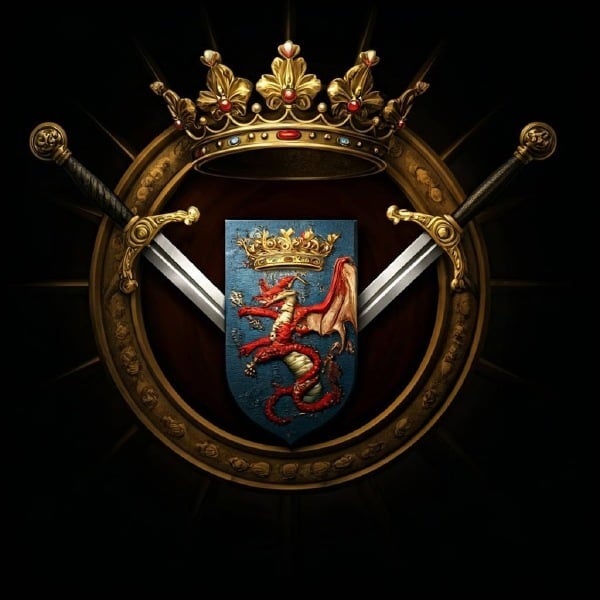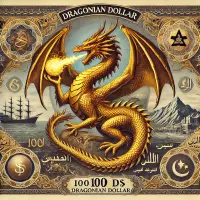| National Factbook |
| Flag: |

|
| Nation Name: |
Kingdom Of Dragonia |
| Leader Name: |
Fahim3143 |
| Currency: |

Draconian Dollar |
| National Animal: |

Dragon |
| History: |
History of the Kingdom of Dragonia
Economic Foundation
The Kingdom of Dragonia is blessed with abundant natural resources, including aluminum, oil, and uranium, which have become the backbone of its economy and military power. These resources fuel Dragonia’s rapid development and provide the kingdom with a strategic advantage in both trade and warfare.
Aluminum drives the kingdom’s industrial growth, aiding in infrastructure and military manufacturing. Oil ensures energy security and provides export wealth, while uranium positions Dragonia as a key player in nuclear technology and advanced weaponry.
Vision for Resource Utilization
Under the leadership of Sultan Mohammed Foysal Rahman, Dragonia has prioritized leveraging its natural resources to dominate regional politics and secure a lasting legacy of strength and innovation. By combining resource wealth with its imperial ambitions, the kingdom aspires to solidify its place as a leading power. |
| Geography |
| Continent: |
Africa |
| Land Area: |
32,669.60 sq. km |
| Terrain: |
The Kingdom of Dragonia is blessed with mixed terrain, which offers a variety of strategic advantages for its growth and defense. The kingdom is composed of three primary geographic features:
1. Mountainous Regions: The northern and central parts of Dragonia are dominated by rugged mountains, providing natural fortifications against invaders. These mountains are rich in valuable minerals, including uranium, and serve as a crucial resource for the kingdom’s military and technological advancements.
2. Savannah Plains: To the south, expansive plains stretch across the kingdom, perfect for agriculture and livestock grazing. The fertile soil and open space allow Dragonia to produce food and resources, supporting its growing population and sustaining its military campaigns.
3. Coastal Areas: Dragonia’s coastline runs along the western edge, where the kingdom controls vital ports and trade routes. The coast is rich in oil, and the presence of rivers and natural harbors enables Dragonia to maintain a powerful navy, conduct piracy, and secure resources from distant lands.
This mixed terrain allows Dragonia to thrive, providing a diverse ecosystem for its people and a strong foundation for both economic growth and military conquest. |
| Highest Peak: |
Mount Drakhan,
7,800 meters
|
| Lowest Valley: |
Valley of Sha’ah,
-150 meters
|
| Climate: |
Given the mixed terrain of the Kingdom of Dragonia, its climate can vary across regions, providing a dynamic and adaptable environment. Here’s a suggested breakdown of the climate:
1. Mountainous Regions:
• Climate: Cool to cold, with high-altitude weather patterns. Winters bring snow to the peaks, while summers are mild but can still experience cold spells.
• Effect: These regions are ideal for mining and natural resource extraction, with limited agriculture due to the cold temperatures but abundant minerals like uranium.
2. Savannah Plains:
• Climate: Warm and semi-arid, with distinct wet and dry seasons. During the dry season, temperatures can soar, while the rainy season brings brief but heavy showers.
• Effect: The plains are well-suited for agriculture and livestock, though the dry season can be harsh. These regions support Dragonia’s agricultural needs and are essential for its economy.
3. Coastal Areas:
• Climate: Tropical to subtropical, with high humidity and frequent rainfall, particularly during the monsoon seasons. Temperatures are warm year-round.
• Effect: The coastal areas are great for trade and naval operations, with fertile lands supporting fishing and resource extraction. The warm waters and rainy season also contribute to the kingdom’s natural resource wealth.
This combination of climates allows Dragonia to maintain a balanced economy and military strength, using the varied regions to their full advantage. |
| People & Society |
| Population: |
1,224,000 people |
| Demonym: |
Dragonian |
| Demonym Plural: |
Dronians |
| Ethnic Groups: |
The Drakhanis - 85.0%
The Saharani - 10.5%
The Nyaru - 4.5% |
| Languages: |
English - 98.0%
Latin - 72.0%
Bangla - 49.0% |
| Religions: |
Islam - 95.0%
Animism - 3.0%
Christian - 2.0% |
| Health |
| Life Expectancy: |
77 years |
| Obesity: |
15% |
| Alcohol Users: |
2% |
| Tobacco Users: |
18% |
| Cannabis Users: |
0% |
| Hard Drug Users: |
1% |
| Economy |
| Description: |
If the Kingdom of Dragonia does not have a significant industrial sector, its economy would be more reliant on natural resources, agriculture, trade, and military conquest. Here’s how the economy could look without a focus on heavy industry:
Primary Sources of Income
1. Natural Resources
• Oil: Oil remains Dragonia’s most valuable resource, with extraction, refining, and export serving as the backbone of the kingdom’s economy. The revenue generated from oil exports would sustain the economy, allowing the government to fund the military and maintain infrastructure.
• Aluminum and Uranium: While the absence of large-scale manufacturing or refining industries might limit the kingdom’s ability to process these resources, the extraction of aluminum and uranium would still provide income through exports to other nations, particularly for use in energy and military technologies.
2. Agriculture and Livestock
• Agricultural Output: Without industrial manufacturing, agriculture becomes more important for sustaining the population. Crops grown in the plains, such as grains, vegetables, and fruits, would supply food domestically and for export to neighboring regions.
• Livestock: Cattle, camels, and goats would be essential for food, transportation, and trade. In rural areas, traditional farming and livestock herding would be the primary economic activities.
3. Fishing and Coastal Trade
• The coastal regions would focus on fishing and the export of seafood. With no significant industry, the kingdom would depend on trade routes along the coasts to facilitate the exchange of goods, both from Dragonia and through imports.
• Piracy and Raiding: As part of the kingdom’s military and pirate policies, raids on neighboring trade routes and coastal nations could provide additional wealth. Seizing goods from weaker states or rival powers would offer both material wealth and strategic advantage.
Trade and Diplomacy
• Without industrial capacity, Dragonia would rely heavily on exports of raw materials like oil, aluminum, and uranium to maintain economic ties with other nations.
• Trade Relationships: The kingdom would likely enter into trade agreements, exchanging resources with more industrialized or technologically advanced nations in return for goods and services that Dragonia cannot produce locally.
• Military Influence: The absence of a robust industrial base means that Dragonia might focus on military alliances, offering its strategic resources in exchange for military support, weapons, or technological advancements.
Economic Challenges
1. Dependence on Natural Resources
• Dragonia’s economy would be extremely vulnerable to global market fluctuations, particularly in the price of oil and other natural resources. If global demand for these resources were to decrease, the kingdom would face significant economic downturns.
2. Lack of Technological Advancement
• Without industry, Dragonia would likely fall behind in technological development, limiting its ability to modernize its military and infrastructure, and reducing its competitive edge on the global stage.
3. Limited Employment Opportunities
• With no industrial sector, many of the kingdom’s citizens would work in agriculture, mining, and fishing. Urban centers would likely focus on trade and military service, but overall employment might be more limited and dependent on the kingdom’s natural resources.
4. Social Inequality
• The elite class in Dragonia, particularly those involved in the military and resource extraction, would control most of the wealth, leaving the common population to rely on more manual labor. This could lead to inequality between those who control the kingdom’s resources and those who work the land or in the extraction industries.
Currency (Dragonian Dollar - D$)
• The Dragonian Dollar (D$) would continue to be the official currency, supported mainly by exports of oil and raw minerals. The value of the dollar would depend on the global demand for these resources, and the kingdom may face challenges in currency stability if prices drop.
Overall Economic Outlook
• The kingdom’s economy would remain resource-dependent and unequal, but the absence of industrial development might allow for a more simplified and militarized society. Trade and raiding would provide key sources of wealth, but the kingdom would need to maintain strong military forces to protect its resources and trade routes. |
| Average Yearly Income: |
$89.97 |
| Gross Domestic Product (GDP): |
$2,664,347,845.00 |
| GDP per Capita: |
$2,176.75 |
| Gross National Income (GNI): |
$1,907,394,005.00 |
| Industries: |
Given that Kingdom of Dragonia is focusing more on natural resources and trade, the industrial sector, although limited, would still play an important role in supporting the economy. However, instead of heavy manufacturing, Dragonia would likely have industries that support its military, resource extraction, agriculture, and trade. Here’s an overview of the key industries that might exist in the kingdom:
Key Industries in Dragonia
1. Resource Extraction and Processing
• Oil Extraction and Refining:
The oil industry is a cornerstone of the economy. Dragonia would have facilities for crude oil extraction, refining, and export. This would involve mining equipment, refineries, and pipelines for both domestic use and international trade.
Exports would likely fuel the kingdom’s wealth, with refineries focused on producing petroleum and related products.
• Mining (Aluminum and Uranium):
While not a large-scale manufacturing industry, mining of aluminum and uranium would be significant. Mines would be established to extract these resources, with some degree of processing occurring locally before being exported. This industry is crucial for trade and potential military applications (like nuclear energy or weapons).
2. Agriculture
• Crop Production:
Agriculture in Dragonia would include the cultivation of grains, vegetables, fruits, and possibly cotton. While the kingdom’s desert climate may limit agricultural capacity, the plains and coastal areas would be fertile enough to support large-scale farming operations.
This sector would also involve industries focused on the processing and packaging of agricultural goods, such as grain milling and fruit canning.
• Livestock Farming:
Dragonia would have a thriving livestock industry that focuses on raising cattle, goats, and camels. These animals would be used for food, transportation, and trade. Meatpacking and leather goods would be industries that process the output of the livestock sector.
3. Shipbuilding and Maritime Industry
• Given Dragonia’s pirate and raiding policies, shipbuilding would be an important industry, particularly along the coast. The construction of naval vessels for military and trade purposes would be central to the kingdom’s military focus.
• Shipyards would produce ships, especially for military purposes, but there could also be some commercial ships built for trade.
• Maritime transportation and port management would also be key industries, facilitating the kingdom’s import and export activities.
4. Textiles and Handicrafts
• While not as industrialized as more advanced economies, Dragonia may have a textile industry for clothing, weaving, and leatherwork, particularly in the rural and nomadic communities.
• Craftsmanship in metalwork, carpentry, and pottery could be locally important in both traditional and military uses.
5. Defense and Military Industries
• The absence of a large-scale industrial sector does not mean Dragonia would lack military production. In fact, Dragonia would likely have specialized military industries focused on:
• Weapons manufacturing (guns, knives, bombs, etc.)
• Ammunition production
• Armor and military vehicles
• Naval equipment and boats
• These industries would support Dragonia’s imperial and pirate-like ambitions, ensuring that the kingdom has the resources to maintain a strong military and expand its influence.
6. Construction and Infrastructure
• Construction would be focused on infrastructure to support both military and civilian needs. This includes the building of roads, fortifications, ports, and government buildings.
• Housing and urban development would also be part of this industry, particularly in coastal cities and urban centers where trade and military presence are concentrated.
Impact of Limited Industry
Without heavy manufacturing industries, Dragonia’s economy would be relatively simple but resource-rich. The focus on extraction (oil, aluminum, uranium), agriculture, and defense would define the kingdom’s economic structure, making it highly dependent on the export of raw materials. This lack of manufacturing would limit the development of consumer goods industries and technological advancements, meaning that the kingdom’s wealth would largely come from trade, raiding, and exploitation of resources rather than product manufacturing.
Challenges
• Dependence on Imports: Without a robust industrial base, Dragonia would have to rely heavily on imports for manufactured goods like electronics, luxury items, and advanced machinery. This could make the kingdom vulnerable to supply chain disruptions.
• Economic Vulnerability: The kingdom’s economy could suffer if global demand for its oil or aluminum were to decrease, as there would be few alternative industries to absorb the shock. |
| Military |
| History: |
The Kingdom of Dragonia’s military is a central aspect of its power and identity, closely tied to its imperialist policies and pirate-based war strategies. Given its focus on raiding and expansion, the kingdom’s military would be highly organized, aggressive, and equipped for both defensive and offensive operations. Below is an overview of the key elements of the Kingdom of Dragonia’s military:
Military Structure
1. Absolute Monarchy Leadership
• The military is directly controlled by King Mohammed Foysal Rahman, as the head of state. The king, as an absolute monarch, has the final say in all military matters, ensuring that the armed forces are loyal to the crown and serve his imperial ambitions.
• The king is advised by a Royal Military Council, which includes generals, military strategists, and advisors from various branches of the armed forces.
2. Military Branches
• Royal Army (Land Forces)
• The Royal Army is tasked with land-based operations—defending the kingdom’s borders, expanding territory, and engaging in ground-based raids.
• The army would be divided into elite infantry, artillery divisions, and special forces (e.g., guerrilla or commando units), especially for raiding operations into neighboring territories.
• Key units:
• Heavy Infantry: Well-trained and equipped for close combat and defense.
• Special Forces: Specialized units trained for sabotage, raids, and covert operations.
• Royal Navy (Sea Forces)
• The Royal Navy plays a crucial role in Dragonia’s pirate-based war policy, focusing on naval raids, piracy, and controlling important trade routes.
• The navy would have a mix of raiding ships, destroyers, and transport vessels for naval expeditions.
• The pirate navy would focus on hit-and-run tactics, ambushing trade routes, and conducting raids on vulnerable coastal cities.
• Key units:
• Raiding Fleets: Ships equipped with boarding parties, heavy cannons, and fast attack vessels.
• Naval Special Forces: Trained for underwater and coastal operations, such as destroying enemy vessels or infiltrating port cities.
• Royal Air Force (Aerial Forces)
• While the Royal Air Force would be less developed compared to the army and navy, it would have a modest air fleet equipped with surveillance drones, fighter aircraft, and bombers for raids and defensive actions.
• The air force’s role would also include reconnaissance over enemy territories and ensuring air superiority during imperial campaigns.
• Key units:
• Bomber Squadrons: Used for aerial strikes against enemy infrastructure or coastal defenses.
• Reconnaissance Units: Aerial surveillance to track enemy movements and plan raids.
3. Military Units and Special Forces
• Tiger Corps: A special elite unit of soldiers named after the national animal, the tiger. This unit is specially trained for rapid strikes, ambushes, and covert operations. The Tiger Corps is known for being highly disciplined and deadly.
• Raiding Squads: Given the pirate war policy, raiding squads would be integral to the military. These small, highly mobile groups are trained to infiltrate enemy territory, strike quickly, and retreat without leaving traces. They would use light vehicles, camouflage, and stealth techniques to conduct hit-and-run operations.
• Camel Cavalry: A traditional but effective unit adapted to Dragonia’s desert and mixed terrain. Camel-mounted forces would be used for reconnaissance, desert warfare, and rapid strikes across vast terrains.
Military Tactics and Strategy
1. Raiding and Piracy
• The Kingdom of Dragonia’s war policy is rooted in piracy and raiding, making the military highly adept at quick strikes against enemy resources, trade routes, and coastal regions.
• Naval raids are particularly significant, with the navy conducting surprise attacks on ships, ports, and trade routes to weaken enemy economies and steal valuable goods.
• Land raids are conducted by the army, often targeting weaker neighboring nations or colonial territories. The focus is on seizing resources and territory through swift military action.
2. Imperialist Expansion
• While raiding is an essential part of Dragonia’s military operations, the ultimate goal is imperialist expansion—taking control of neighboring regions and resources.
• The army would deploy large-scale invasions when necessary, using military fortifications, siege tactics, and guerrilla warfare to overwhelm enemy positions.
• Annexation would be common, with Dragonia incorporating neighboring regions into the kingdom’s expanding empire.
3. Defensive Tactics
• Fortifications: Given the kingdom’s imperial aspirations, strong fortresses and border defenses would be built to protect Dragonia’s territory from invasion.
• Coastal Defenses: Naval bases and airstrips would be fortified to protect key maritime and trade routes. The navy would be stationed at strategic ports to defend against foreign incursions.
Military Technology and Equipment
1. Weapons
• Small Arms: Soldiers are equipped with a variety of firearms, including rifles, pistols, and bladed weapons for close combat. The Tiger Corps would be equipped with high-end weaponry for stealth and efficiency.
• Artillery: The army would use cannons, mortars, and rockets for heavy bombardment during sieges or raids.
• Naval Weapons: The navy would employ cannon fire, ballistae, and boarding weapons for close-quarters combat during piracy and naval battles.
2. Vehicles and Transportation
• Camel Cavalry: Used for desert mobility, this unit employs camels as transport for fast raids across sandy plains and deserts.
• Raiding Ships: The navy would have fast raid vessels, armed with cannon fire and boarding parties for attacking coastal settlements.
3. Aerial Technology
• The Royal Air Force would likely use spy drones, fighter jets, and bombers for both surveillance and aerial attacks. While not as advanced as other countries, Dragonia’s air capabilities would be growing, with a focus on military reconnaissance and targeted strikes.
Military Funding and Resources
• Oil Revenue: The kingdom’s oil wealth would provide most of the funding for the military, enabling Dragonia to maintain its navy, army, and air force.
• Resource Control: The kingdom’s control over aluminum and uranium provides the necessary materials for weapons production and military infrastructure.
Military Challenges and Weaknesses
• Technological Lag: Dragonia may lag behind more technologically advanced nations in terms of weaponry and military technology.
• Global Tensions: The kingdom’s focus on piracy and imperialism could attract the attention of more powerful neighbors or global powers, possibly leading to external conflict.
• Supply Chain Vulnerabilities: The kingdom’s reliance on natural resources might make it vulnerable to disruptions in its supply chains, especially in times of war. |
| Soldiers: |
75,000 |
| Tanks: |
6,250 |
| Aircraft: |
375 |
| Ships: |
75 |
| Missiles: |
0 |
| Nuclear Weapons: |
0 |
| Last Updated: 01/22/2025 12:54 pm |



















